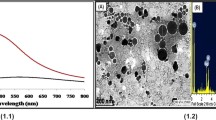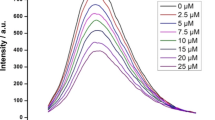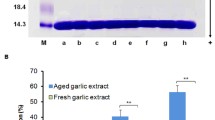Abstract
Advanced glycation end products are major contributors to the pathology of diabetes, Alzheimer’s disease, and atherosclerosis; accordingly, identification of antiglycation compounds is attracting considerable interest. In the present study, the inhibitory effect of gum arabic capped-silver nanoparticles on advanced glycation end products formation was monitored by several biophysical techniques. Silver nanoparticles were characterized by ultraviolet–visible, high-resolution transmission electron microscopy, and energy-dispersive X-ray spectroscopy. Bovine serum albumin and methylglyoxal mixtures incubated with increasing concentrations of silver nanoparticles showed significant reductions in advanced glycation end product formation that were confirmed by ultraviolet–visible, fluorescence spectrometry, and high-performance liquid chromatography techniques. High-performance liquid chromatography showed decreased adduct formation of glycated protein in the presence of silver nanoparticles. The structural changes induced by silver nanoparticles were further confirmed by circular dichroism and Fourier transform infrared spectroscopy. Strong inhibition of advanced glycation end product formation was observed in the presence of elevated silver nanoparticles. The results of this study suggest that silver nanoparticles are a potent antiglycating agent.







Similar content being viewed by others
References
Maillard, L. C. (1912). Comptes Rendus, 154, 66–68.
Thorpe, S. R., & Baynes, J. W. (2003). Amino Acids, 25, 275–81.
Selvin, E., Steffes, M. W., Zhu, H., et al. (2010). New England Journal of Medicine, 362, 800–11.
Yan, S. D., Chen, X., Schmidt, A. M., et al. (1994). Proceedings of the National Academy of Sciences, 91, 7787–91.
Horiuchi, S. (1996). Trends in Cardiovascular Medicine, 6, 163–8.
Thornalley, P. J. (2008). Drug Metabolism and Drug Interactions, 23, 125–50.
Thornalley, P. J., Langborg, A., & Minhas, H. S. (1999). The Biochemical Journal, 344, 109–16.
Monnier, V. M., & Cerami, A. (1981). Science, 211, 491–93.
Nagao, M., Fujita, Y., Wakabayashi, K., Nukaya, H., Kosuge, T., & Sugimura, T. (1981). Environmental Health Perspectives, 67, 89–91.
Moree-Testa, P., & Saint-Jalm, Y. (1981). Journal of Chromatography, 217, 197–20.
Westwood, M. E., & Thornalley, P. J. (1996). Immunology Letters, 50, 17–21.
Lo, T. W. C., Westwood, M. E., McLellan, A. C., Selwood, T., & Thornalley, P. J. (1994). The Journal of Biological Chemistry, 269, 32299–305.
Westwood, M. E., McLellan, A. C., & Thornalley, P. J. (1994). The Journal of Biological Chemistry, 269, 32293–98.
Krymkiewicz, N. (1973). EBS Letters, 29, 51–4.
Brownlee, M., Vlassara, H., Kooney, A., Ulrich, P., & Cerami, A. (1996). Science, 232, 1629–32.
Huby, R., & Harding, J. J. (1988). Experimental Eye Research, 47, 53–59.
Booth, A. A., Khalifah, R. G., & Hudson, B. G. (1996). Biochemical and Biophysical Research Communications, 220, 113–19.
Klein, J. (2007). Proceedings of the National Academy of Sciences of the United States of America, 104, 2029–2030.
Ansari, M. A., Haris, M. K., Aijaz, A. K., Asfia, S., Shahid, M., Shujatullah, F., & Azam, A. (2011). Biologie Médicale, 3, 141–146.
Ansari, M.A., Haris, M.K., Aijaz, A.K., Ahmad, M.K. Mahdi, A.A., Pal, R., and Cameotra, S.S. (2013In Press) J Basic Microbiol DOI: 10.1002/jobm.201300457.
Singha, S., Bhattacharya, J., Datta, H., & Dasgupta, A. K. (2009). Nanomedicine, 5, 21–29.
Sheikpranbabu, S., Kalishwaralal, K., Lee, K., Vaidyanathan, R., Eom, S. H., & Gurunanak, S. (2010). Biomaterials, 31, 2260–71.
Harmsen, B. J., & Braam, W. G. (1969). International Journal Peptide Research, 1, 225–33.
Cedervall, T., Lynch, I., Lindman, S., & Berggard, T. (2007). Proceedings of the National Academy of Sciences, 104, 2050–55.
Gordillo, E., Ayala, A., Bautista, J., and Machado. (1989) J Biol Chem 264, 17024–28.
Monnier, V. M., Kohn, R. R., & Cerami, A. (1984). Proceedings of the National Academy of Sciences, 81, 583–87.
Elgawish, A., Glomb, M., Freidlander, M., & Monnier, V. M. (1996). The Journal of Biological Chemistry, 271, 12964–71.
Vlassara, H., Brownlee, M., & Cerami, A. (1983). Diabetes, 32, 670–74.
Phillips, S. A., Mirrlees, D., & Thornalley, P. J. (1993). Biochemical Pharmacology, 46, 805–11.
McLellan, A. C., Thornalley, P. J., Benn, J., & Sonksen, P. H. (1994). Clinical Science, 87, 21–29.
Jisha, V. S., Arun, K. T., Hariharan, M., & Ramaiah, D. (2006). Journal of the American Chemical Society, 128, 6024–25.
Banerjee, T., Singh, S. K., & Kishore, N. (2006). The Journal of Physical Chemistry, 110, 24147–56.
Chithrani, B. D., Ghazani, A. A., & Chan, W. C. (2006). Nano Letters, 6, 662–68.
Schmitt, A., Schmitt, J., Munch, G., & Gasic-Milenkovic, J. (2005). Analytical Biochemistry, 338, 201–15.
Bhattacharya, J., Jasrapuria, S., Sarkar, T., et al. (2007). Nanomedicine, 3, 4–19.
Kim, J., Hong, C., Koo, Y., Choi, H., & Lee, K. (2012). Biological and Pharmaceutical Bulletin, 35, 260–64.
Sastry, M., Kumar, A., Datar, S., Dharmadhikari, C. V., & Ganesh, K. N. (2001). Applied Physics Letters, 78, 2943.
Acknowledgments
The authors thank Yeungnam University for providing financial assistance to Jalaluddin M. Ashraf. The authors also would like to acknowledge the SAIF-DST, Department of Anatomy, All India Institute of Medical Sciences (AIIMS), New Delhi, India, for HR-TEM observations, as well as the Center for Excellence in Nanomaterials, Department of Applied Physics, AMU, Aligarh, for ATR-FTIR analysis.
Author information
Authors and Affiliations
Corresponding author
Additional information
Jalaluddin M. Ashraf and Mohammad Azam Ansari are contributed equally to this work.
Rights and permissions
About this article
Cite this article
Ashraf, J.M., Ansari, M.A., Choi, I. et al. Antiglycating Potential of Gum Arabic Capped-Silver Nanoparticles. Appl Biochem Biotechnol 174, 398–410 (2014). https://doi.org/10.1007/s12010-014-1065-1
Received:
Accepted:
Published:
Issue Date:
DOI: https://doi.org/10.1007/s12010-014-1065-1




